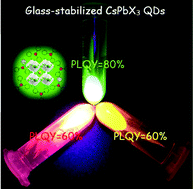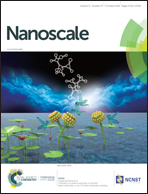Promoting photoluminescence quantum yields of glass-stabilized CsPbX3 (X = Cl, Br, I) perovskite quantum dots through fluorine doping†
Abstract
In the last few years, all-inorganic cesium lead halide (CsPbX3) quantum dots have shown unprecedented radical progress for practical applications in the optoelectronic field, but they quickly decompose when exposed to air. The in situ growth of the CsPbX3 particles inside amorphous glass can significantly improve their stability. Unfortunately, it is formidably difficult to precipitate whole-family CsPbX3 from a glass matrix and their photoluminescence quantum yields require further improvement. Herein, fluoride additives were introduced into oxyhalide borosilicate glasses to break the tight glass network, which promoted the nucleation/growth of CsPbX3 (X = Cl, Cl/Br, Br, Br/I and I) inside the glass. Importantly, the quantum efficiencies of glass-stabilized CsPbBr3, CsPb(Br/I)3 and CsPbI3 reached 80%, 60% and 50%, respectively, which are the highest efficiencies reported so far. Benefiting from the effective protection of robust glass, CsPbX3 quantum dots exhibited superior water resistance with more than 90% luminescence remaining after immersing them in water for 30 days, and halogen anion exchange among different CsPbX3 materials was completely inhibited. Two prototype light-emitting diodes were constructed by coupling green/red and green/orange/red quantum dots with InGaN blue chips, yielding bright white light with optimal luminous efficiency of 93 lm W−1, tunable color temperature of 2000–5800 K and high color rendering index of 90.

- This article is part of the themed collection: Quantum Dots: A Nanoscience Nobel Prize


 Please wait while we load your content...
Please wait while we load your content...